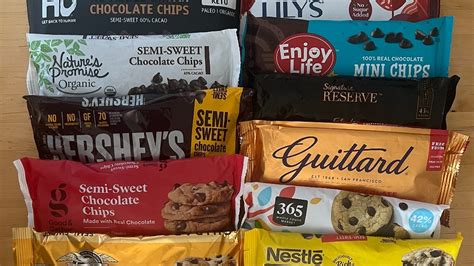
A popular chocolate chip brand is facing scrutiny after home bakers have reported consistent melting failures, resulting in ruined cookies, cakes, and other desserts. Instead of producing the expected pockets of melted chocolate, the chips are allegedly retaining their shape and failing to integrate properly into baked goods, leading to a wave of disappointment and frustration among consumers.
Nestlé Toll House semi-sweet chocolate morsels are at the heart of the controversy. Numerous bakers have taken to social media platforms, cooking blogs, and online review sites to share their experiences, posting photos and videos of cookies dotted with unmelted, hard chocolate chips. They claim that despite following recipes precisely, the chocolate chips remain stubbornly intact, failing to deliver the gooey, melty texture expected in chocolate chip-based treats. This has led to widespread calls for an investigation into the quality and composition of the chocolate chips.
The issue appears to be more pervasive than isolated incidents. Many bakers have described using the chips for years without issue, suggesting a potential change in the manufacturing process, ingredients, or storage conditions. Some speculate that the formulation of the chips may have been altered to improve shelf stability, unintentionally affecting their melting properties. Others point to potential issues in the supply chain, such as improper storage during transportation or in retail environments, which could affect the chocolate’s consistency.
“I’ve been baking with Nestlé Toll House for 30 years and something is definitely different,” stated Sarah Miller, a home baker from Ohio, in a widely circulated social media post. “My cookies used to be perfect, but now the chocolate chips just sit there like little pebbles. They don’t melt at all.”
The complaints aren’t limited to cookies. Bakers report similar issues when using the chocolate chips in brownies, muffins, and even in melted chocolate applications like ganache. This broad range of applications affected suggests the problem isn’t specific to one baking method but is intrinsic to the chocolate chips themselves.
Nestlé has responded to the growing criticism, stating they are aware of the concerns and are actively investigating the matter. In a statement released to several media outlets, a spokesperson for Nestlé Toll House said, “We are committed to providing high-quality products and are taking these reports very seriously. We encourage consumers to contact us directly with any concerns so we can gather more information and address their issues.” The company has not yet offered a definitive explanation for the reported melting failures.
The backlash highlights the critical role of ingredient quality in baking and the significant impact even minor changes can have on the final product. For many home bakers, baking is not just a hobby but a way to express creativity, share love, and create comforting treats for family and friends. When a key ingredient fails to perform as expected, it can be deeply disappointing.
Adding to the complexity, several factors can influence the melting behavior of chocolate chips. The type of chocolate (e.g., semi-sweet, milk chocolate, dark chocolate), the fat content, and the presence of additives like emulsifiers can all play a role. The baking temperature, oven type, and even the altitude at which the baking takes place can also affect how chocolate melts.
Experts in the field have weighed in on the issue, suggesting possible causes and offering advice to frustrated bakers. Food scientist Dr. Emily Carter explained, “Chocolate is a complex substance, and its melting point is influenced by several factors. Changes in the cocoa butter content, the addition of stabilizers, or even variations in the cooling process during manufacturing can all affect how it melts. It’s possible that a subtle change in the formulation, intended to improve another aspect of the product, inadvertently altered its melting properties.”
Until Nestlé provides a concrete explanation and a solution, bakers are left to experiment with alternative brands or adjust their baking techniques in an attempt to overcome the melting issues. Some bakers recommend chopping the chocolate chips into smaller pieces to promote melting, while others suggest using a different brand of chocolate chips altogether.
The incident serves as a reminder of the importance of quality control in the food industry and the need for transparency in addressing consumer concerns. It also underscores the power of social media in amplifying customer feedback and holding companies accountable for product performance. The outcome of Nestlé’s investigation and their response to the issue will likely determine the future of the brand’s reputation among home bakers and chocolate lovers alike.
The situation also reignites a broader conversation about the impact of mass production on food quality. As companies strive to optimize efficiency and reduce costs, there’s a risk of compromising the quality and performance of ingredients. This can lead to consumer dissatisfaction and erode trust in established brands.
Beyond the immediate frustration of ruined desserts, the chocolate chip saga highlights the emotional connection people have with food and the rituals surrounding cooking and baking. For many, the act of baking is a source of comfort, creativity, and connection. When a familiar and reliable ingredient fails, it can disrupt these positive associations and lead to a sense of disappointment and loss.
The unfolding situation underscores the need for continuous monitoring and evaluation of product quality in the food industry. Companies must be vigilant in identifying and addressing any issues that could affect the performance of their products, especially those that are widely used and trusted by consumers. Transparent communication and a willingness to listen to customer feedback are also essential for maintaining brand loyalty and reputation.
In the meantime, bakers are sharing tips and tricks on social media to mitigate the melting issues. Some recommend using chocolate chunks instead of chocolate chips, while others suggest adding a small amount of vegetable oil to the dough to help the chocolate melt more smoothly. However, these are only temporary solutions to a problem that requires a more fundamental fix from the manufacturer.
The chocolate chip conundrum serves as a case study in how even seemingly minor changes in food production can have significant consequences for consumers. It also illustrates the power of online communities in sharing information, voicing concerns, and holding companies accountable. As Nestlé continues its investigation, the baking community will be watching closely, hoping for a resolution that restores their faith in a beloved baking staple.
The long-term effects on Nestlé’s brand reputation remain to be seen. The company’s response to the crisis, including the transparency of its investigation and the solutions it offers, will be crucial in determining whether it can regain the trust of disillusioned bakers. The incident also highlights the importance of diversifying ingredient choices and not solely relying on one brand, especially when alternatives exist that may offer more consistent results.
The narrative also touches upon the changing landscape of food production and consumption. With increased awareness of ingredients and manufacturing processes, consumers are becoming more discerning and demanding in their expectations. They are no longer willing to accept substandard quality or unexplained inconsistencies in the products they purchase. This shift in consumer behavior is driving companies to be more transparent and accountable in their operations.
The chocolate chip controversy is a microcosm of broader issues affecting the food industry, including the balance between mass production and quality control, the impact of supply chain disruptions, and the growing importance of consumer feedback. It serves as a reminder that even the most established brands must remain vigilant in maintaining the quality and consistency of their products to retain the trust and loyalty of their customers.
As the story unfolds, it is clear that the humble chocolate chip has become a symbol of broader concerns about food quality, corporate responsibility, and the changing relationship between consumers and the brands they rely on. The baking community awaits the resolution of this “baking blunder” with bated breath, hoping for a return to the days of perfectly melted chocolate chips in their beloved desserts.
Frequently Asked Questions (FAQs):
-
What is the main issue with Nestlé Toll House chocolate chips?
- The main issue is that many home bakers are reporting that Nestlé Toll House semi-sweet chocolate morsels are not melting properly when used in baked goods such as cookies, cakes, and brownies. Instead of melting into gooey pockets of chocolate, the chips are retaining their shape and remaining hard.
-
What are the common complaints about these chocolate chips?
- Common complaints include the chocolate chips not melting even when following recipes precisely, the chips remaining intact like “pebbles” in the baked goods, and a noticeable difference in melting behavior compared to past experiences with the same brand. Bakers report these issues across various applications, not just cookies, including brownies, muffins, and even in ganache.
-
Has Nestlé responded to the complaints?
- Yes, Nestlé has acknowledged the complaints and stated that they are taking them seriously. A spokesperson for Nestlé Toll House said, “We are committed to providing high-quality products and are taking these reports very seriously. We encourage consumers to contact us directly with any concerns so we can gather more information and address their issues.” They are currently investigating the matter.
-
What are some possible reasons for the chocolate chips not melting?
- Possible reasons include changes in the manufacturing process, alterations to the chocolate chip formulation (such as changes in cocoa butter content or the addition of stabilizers to improve shelf life), or issues in the supply chain that could affect the chocolate’s consistency, such as improper storage during transportation or at retail locations.
-
What are bakers suggesting as alternatives or solutions in the meantime?
- Bakers are suggesting several alternatives and solutions, including:
- Using different brands of chocolate chips.
- Chopping the chocolate chips into smaller pieces to promote melting.
- Using chocolate chunks instead of chocolate chips.
- Adding a small amount of vegetable oil to the dough to help the chocolate melt more smoothly.
- Bakers are suggesting several alternatives and solutions, including:
-
Are all types of Nestlé Toll House chocolate chips affected?
- While the reports predominantly focus on the semi-sweet chocolate morsels, there is not yet conclusive information available as to whether other varieties of Nestlé Toll House chocolate chips (such as milk chocolate or dark chocolate) are similarly affected. However, the reports indicate that semi-sweet chocolate morsels are at the heart of the issue.
-
How long have bakers been noticing this problem?
- Many bakers state that they have been using Nestlé Toll House chocolate chips for years without any issues, but they have recently noticed a significant change in the melting behavior. This suggests that the problem may be a relatively recent development, potentially linked to a recent change in the manufacturing process or ingredients.
-
What role does the type of oven play in the melting issue?
- While the oven type (conventional vs. convection) and baking temperature can influence how chocolate melts, the consistent reports of unmelted chocolate chips across different baking setups suggest that the core issue lies with the chocolate chips themselves, rather than solely with the baking method. However, ensuring accurate oven temperature and appropriate baking times is always crucial for successful baking.
-
Is there any scientific evidence to support the claim of a change in the chocolate chips’ formulation?
- Currently, there is no publicly available scientific evidence or official confirmation from Nestlé regarding changes to the chocolate chip formulation. The speculation about formulation changes is based on the observations and experiences shared by bakers, as well as expert opinions from food scientists who suggest that even subtle changes in ingredients or manufacturing processes can affect the melting properties of chocolate.
-
What impact could this issue have on Nestlé’s brand reputation and sales?
- The issue has the potential to negatively impact Nestlé’s brand reputation and sales, especially if the company doesn’t address the concerns effectively and transparently. Dissatisfied customers may switch to alternative brands, and negative reviews and social media posts can further erode consumer trust. The long-term impact will depend on Nestlé’s response, including its investigation, communication with customers, and any corrective actions taken.
-
How does cocoa butter content affect the melting properties of chocolate chips?
- Cocoa butter is a key component of chocolate that significantly influences its melting properties. A higher cocoa butter content generally results in smoother, more easily melted chocolate. If the cocoa butter content is reduced or if other fats are added, the chocolate may not melt as readily or evenly. Changes in the source or processing of cocoa butter can also affect its melting characteristics.
-
What are the implications of this issue for smaller chocolate chip brands?
- The issues with Nestlé Toll House could create an opportunity for smaller chocolate chip brands to gain market share by emphasizing the quality, consistency, and melting properties of their products. Bakers may be more willing to try alternative brands if they are dissatisfied with the performance of a well-known brand like Nestlé. Smaller brands that focus on using high-quality ingredients and maintaining consistent manufacturing processes may benefit from this situation.
-
Could improper storage conditions at home contribute to the melting issues?
- While improper storage can affect the quality and texture of chocolate, it is unlikely to be the primary cause of the widespread melting issues reported by bakers. Storing chocolate in a warm or humid environment can cause it to bloom (develop a white coating) or become grainy, but it typically wouldn’t prevent it from melting altogether. The consistent nature of the complaints across different households suggests that the problem originates with the chocolate chips themselves.
-
What is meant by chocolate “bloom,” and how does it affect chocolate?
- Chocolate bloom refers to a white or grayish coating that can appear on the surface of chocolate. There are two types of bloom: fat bloom and sugar bloom. Fat bloom occurs when fat crystals, usually cocoa butter, migrate to the surface. Sugar bloom occurs when sugar crystals form on the surface due to moisture. Bloom can affect the appearance and texture of chocolate, making it less appealing, but it doesn’t necessarily affect the taste or safety of the chocolate.
-
How does the presence of emulsifiers affect the melting properties of chocolate?
- Emulsifiers, such as lecithin, are often added to chocolate to improve its texture and prevent fat bloom. While emulsifiers can help create a smoother and more stable chocolate, they can also potentially affect its melting properties, particularly if they are used in excessive amounts or if the balance of ingredients is disrupted.
-
What is the role of stabilizers in chocolate chips and how might they affect melting?
- Stabilizers are added to chocolate products to help maintain their texture and prevent separation of ingredients over time. They can include ingredients like vegetable oils or modified starches. While stabilizers contribute to a longer shelf life and a more consistent product, they can also alter the melting behavior of the chocolate. Too many stabilizers or the wrong type can hinder the chocolate’s ability to melt smoothly and evenly.
-
Is the size or shape of the chocolate chip a factor in the melting issues?
- The size and shape of the chocolate chips can influence how quickly and evenly they melt. Smaller chocolate chips generally melt more easily than larger ones because they have a greater surface area exposed to heat. However, the reports of unmelted chips suggest that the size and shape are not the primary cause of the problem, as bakers are experiencing issues even with traditionally sized semi-sweet morsels.
-
How can bakers test their chocolate chips to determine if they will melt properly before using them in a recipe?
- Bakers can perform a small-scale test by melting a small quantity of chocolate chips in a microwave or double boiler to observe their melting behavior. If the chips melt smoothly and evenly, they are likely to perform well in baked goods. If they remain lumpy or do not melt properly, it may indicate an issue with the chocolate.
-
What are food scientists saying about the potential causes of this issue?
- Food scientists suggest that subtle changes in the chocolate chip formulation, variations in the cocoa butter content, the addition of stabilizers, or even variations in the cooling process during manufacturing could affect how the chocolate melts. They emphasize that chocolate is a complex substance and even small changes in its composition or processing can significantly impact its melting properties.
-
What should consumers do if they experience issues with Nestlé Toll House chocolate chips?
- Consumers who experience issues with Nestlé Toll House chocolate chips are encouraged to contact Nestlé directly with their concerns. This allows Nestlé to gather more information about the problem and address individual issues. Consumers can also share their experiences on social media and online review sites to raise awareness and contribute to the collective feedback on the product.









